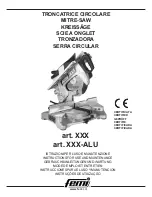
page 4
1.
WARNING!
Some dust created by power sanding, sawing, grinding,
drilling, and other construction activities contains chemicals known
to cause cancer, birth defects or other reproductive harm. Some
examples of these chemicals are:
lead from lead-based paint
crystalline silica from bricks and cement and other masonry
products, and
arsenic and chromium from chemically-treated lumber.
Your risk from these exposures varies, depending on how often
you do this type of work. To reduce your exposure to these chemi-
cals: work in a well ventilated area, and work with approved safety
equipment, such as those dust masks that are specifically designed
to filter out microscopic particles.
2.
Always keep hands away from the path of the saw blade.
3.
Do not defeat the guards of operate the tool without the
guards in place.
4.
Always support work properly.
Use the fence, support blocks,
auxiliary work support or clamps to keep workpiece secure. Al-
ways support the free end of the workpiece and support all small
workpieces. Workpieces that bow and pinch the blade may result in
kick back. Do not perform any operations freehand (unsupported).
5.
Never reach around, under or across blade.
6.
Check guards
for smooth operation before each use.
7.
Avoid kick back.
Kick back is a violent reaction to a pinched or
binding blade, which throws the saw head upward and towards
the operator. Proper workpiece selection and support, proper blade
selection and maintenance, and even feed rate are essential to
reduce the risk of kick back.
8.
Always wait for the blade to stop completely before
chang-
ing positions, retrieving a cut-off piece, or preparing the next cut.
Unplug the tool before tightening blade screw, servicing, making
adjustments, transporting or moving the saw to another location.
9.
Be sure the clamp handle and the bevel adjustment lever
are tightened securely before making cuts.
10.
Do not use abrasive wheels with the miter saw.
11.
Use the right blade.
Use only recommended blade types and
sizes with proper mounting holes, rated at least 5500 RPM. Follow
the rotation arrow on the blade to be sure you install it properly.
Keep saw blades sharp to help prevent cracking and grabbing.
Never use defective or incorrect washers or bolts.
12.
Do not lock the trigger in the on position.
SPECIFIC SAFETY RULES
13.
Wait for the blade to reach full speed before lowering the
saw head to make a cut.
14.
Keep the cord away from the cutting area
and position it so that
it will not be tripped over or caught on the workpiece while you are
cutting.
15.
Do not place hands under the saw motor or in the path of
the blade.
Do not retrieve a piece of material that is cut off while the
blade is rotating. Never place hands or fingers behind or in front of
the saw blade.
16.
Keep blades clean and sharp.
An unsharpened or improperly
sharpened blade produces a narrow kerf and is likely to be pinched
by the workpiece. A dull blade produces excessive friction which
can cause the blade to warp or bind. Be sure the blade screw is
tight to prevent slipping or loosening during operation.
17.
Restarting in mid-cut.
If you stop the saw in mid-cut, allow the
blade to stop, then raise the saw out of the cut. Then restart the
saw.
18.
If the blade stalls, do not turn the switch on and off.
A dull
blade or excess pressure may cause stalling. Release the switch
immediately if the blade binds or the saw stalls and remove the saw
from the cut.
19.
Avoid cutting nails.
Inspect for and remove all nails before cutting.
20.
Thin material
tends to warp or sag and must be well-supported
over its entire length to avoid pinching the blade.
21.
Position fence properly.
The flip fence can be adjusted for com-
pound cuts and miter cuts. Always make sure the fence is adjusted
for the intended cut. Never operate the saw without the fence in
place.
22.
Lock the saw head down and lock the sliding mechanism
before transporting.
23.
Push the saw through the workpiece. Do not pull the saw
through the workpiece.
To make a cut, raise saw head and pull it
out OVER the workpiece WITHOUT cutting, start the motor, wait a
few seconds for the blade to reach full speed, press down on saw
head, and push saw head through the cut.
SERVICE
31.
Tool service must be performed only by qualified repair
personnel.
Service or maintenance performed by unqualified per-
sonnel may result in a risk of injury.
32.
When servicing a tool, use only identical replacement parts.
follow instructions in the maintenance section of this
manual.
Use of unauthorized parts or failure to follow maintenance
instructions may create a risk of shock or injury.
28.
Use proper accessories.
Consult this manual for recommended
accessories. Using improper accessories may be hazardous. Be
sure accessories are properly installed and maintained. Do not de-
feat a guard or other safety device when installing an accessory or
attachment.
29.
Maintain tools carefully.
Keep handles dry, clean and free from
oil and grease. Keep cutting edges sharp and clean. Follow instruc-
tions for lubricating and changing accessories. Periodically inspect
tool cords and extension cords for damage. Have damaged parts
repaired or replaced by a
MILWAUKEE
service facility.
30.
Maintain labels & nameplates.
These carry important informa-
tion. If unreadable or missing, contact a
MILWAUKEE
service facil-
ity for a free replacement.
All manuals and user guides at all-guides.com





































